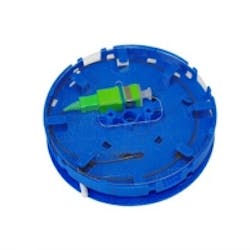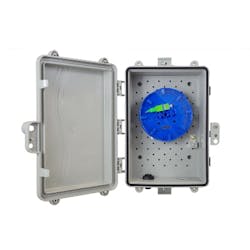Clearfield’s StrongFiber: 900-micron outside-plant fiber-optic drop cable
Clearfield Inc. today announced FieldShield StrongFiber—an outside-plant (OSP)-rated ready-for-in-duct-placement 900-micron optical fiber that the company says “delivers exceptional pull strength in a small form factor. Teamed with other elements within the FieldShield product line, StrongFiber reduces the cost of fiber deployment with reduced installation time, material weight and slack-storage requirement,” Clearfield continues.
Matt Brigham, product marketing manager for Clearfield, adds, “To reduce the cost of broadband deployment, we need to reduce not only the skill and time required for site installation, but also the extent of the pre-engineering required. The size and strength of StrongFiber allow for the product to be deployed in any environment without concern for drop lengths chosen. Teamed with other elements of the FieldShield product line, StrongFiber can be used in most environments in place of flat drop optical cable, where conduit or microduct is being used.”
Clearfield says StrongFiber is the first 900-micron OSP drop cable, explaining the “user may specify standard connectors or FieldShield Pushable Connectors that enable FieldShield StrongFiber to be easily pulled through FieldShield Ruggedized Microduct. Teamed with spooling technology incorporated into Clearfield’s SmartRoute Deploy Reel (shown, above), StrongFiber drop cables of up to 300 feet are shipped in a 4.5x1-inch reel with integrated bulkhead and premated adapter that can be easily mounted into a small-form-factor fiber management element of choice—from customer wall boxes, demarcation points, pedestals and cabinets in SFU/MDU environments.”
The company adds that StrongFiber can be used as an inside-plant (ISP) cable as well and when deployed in the ISP, it “reduces pre-engineering and on-site installation time for MDU [multiple-dwelling unit] and riser deployments.
“The high variability of MDU architectures has made FTTp [fiber-to-the-premises] deployments within those structures a challenge,” Clearfield explains. “Extensive engineering has been required to ensure proper cable lengths. With StrongFiber, pre-engineering is minimal because the 4.5-inch SmartRoute Deploy Reel, upon which StrongFiber is shipped, can be mounted at the destination site (example image shown below) and the desired length simply pulled from the wheel to the access point. The small form factor of the 900-micron fiber makes slack storage minimal and easy to accommodate. The exceptional pull strength of StrongFiber makes it craft-friendly and easy for the technician to handle without fear of fiber damage.”
StrongFiber is now shipping, alongside the other elements of the FieldShield fiber-delivery system.
As a technical primer about the deployment of StrongFiber, Clearfield offers the following technical primer.
One or both ends of the StrongFiber Cable are terminated with a FieldShield Pushable Connector for transport through FieldShield Ruggedized Microduct. Once the pushable connector has reached its destination, the connector assembly is completed with the supplied connector housings and the connector is mated to the adapter. The remaining slack on the reel is pre-stored with no further slack management required. The terminated end on the reel is pre-tested, cleaned, and mated in a Clearfield factory environment, leaving the technician to simply mate the patch cord to the adapter on the wheel. The small form factor of the cable assembly and deploy reel allows the StrongFiber to be pulled, and slack stored, from the customer demarcation point if the service provider chooses. This reduces the size requirements of the access point (above or below grade), providing for a more aesthetically pleasing solution in the neighborhood. With less cable weight and, therefore, less coefficient of friction, installations are more timely and with minimal friction as the cable is pulled through bends and turns throughout the route path.

